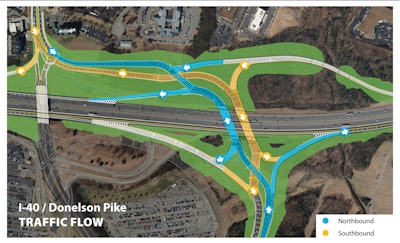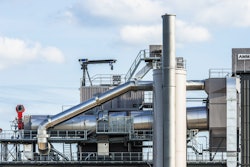![Img 0125[59]](https://img.forconstructionpros.com/files/base/acbm/fcp/image/2022/10/IMG_0125_59_.633b3cac4d0be.png?auto=format%2Ccompress&q=70&w=400)
The Nashville International Airport (BNA) is one of the busiest in the country, and in 2021, the city was ranked1 as the fastest growing in the United States economically. This boom in financial growth has lots of collateral impacts, both directly and indirectly. The original roadways leading into the airport, first constructed in the 1980s, are, and have been for some time, no longer capable of sustaining and adequately serving the traffic demands it now faces.
This, in part, lead to the I-40/Donelson Pike relocation project.
The airport's current loop road currently services the constant stream of arrivals and departures heading into the main terminal entrance. This is also the access used by taxis and ride-share services, so, it isn't difficult to see why it has become so congested. The new Donelson Pike relocation project — spearheaded by Superior Construction and the Tennessee Department of Transportation (TDOT) — is designed to realign the Donelson Pike interchange to the east. This will then allow the Metropolitan Nashville Airport Authority (MNAA) to relocate BNA's loop road to provide a badly needed increase to the airport's circulation capacity, as well as added real estate for more car parking.
Big Relocations, Unique Designs
To achieve this, Superior crews broke ground in July on the relocation of the Donelson Pike interchange at Interstate 40 southeast of downtown Nashville. The plan is to update the junction to a diverging diamond interchange (DDI) design.
The DDI is a subset of diamond interchange in which the opposing directions of travel on the non-freeway road cross each other on either side of the interchange so that traffic crossing the freeway on the overpass or underpass is operating on the opposite driving side from that which is customary for the jurisdiction2.
There are many advantages to this unique type of solution:
- Two-phase signals with short cycle lengths, significantly reducing delay
- Reduced horizontal curvature reduces the risk of off-road crashes
- Increases the capacity of turning movements to and from ramps
- Potentially reduces the number of lanes on the crossroad, minimizing space consumption
- Reduces the number of conflict points, thus theoretically improving safety
- Increases the capacity of an existing overpass or underpass by removing the need for turn lanes
- Costs significantly less than a normal interchange
"We will leverage our experience on other similar projects, including the I-75/SR 56 DDI in Tampa to complete this important project," said Pete Kelley, Chief Operating Officer, Superior Construction. "This traffic design has proven effective and convenient in those communities. Commuters, visitors and residents in this active Nashville area can look forward to the same."
![Img 0131[70]](https://img.forconstructionpros.com/files/base/acbm/fcp/image/2022/10/IMG_0131_70_.633b3c9b01e13.png?auto=format%2Ccompress&fit=max&q=70&w=400) Provided by Superior Construction
Provided by Superior Construction
Despite being used in France since the 1970s, DDIs and their benefits only started gaining more attention in the United States within the last two decades. The first of its kind was only constructed in 2009 in Springfield, Missouri, at the junction between I-44 and Missouri Route 13. However, as of November 2020, there are now 135 DDIs open across the country--a real boom of growth in just eleven years’ time.
However, despite its advantages, there can be some documented/situational drawbacks from using the DDI design in some cases, such as:
- Potential confusion for drivers who are unfamiliar with the configuration
- Pedestrian access requires at least four crosswalks
- Free-flowing traffic in both directions on the non-freeway road is impossible, as the signals cannot be green at both intersections for both directions simultaneously.
- Highway bus stops are appropriately sited outside the interchange.
- Allowing exiting traffic to re-enter the through road in the same direction requires leaving the interchange on the local road and turning around
Managing the Flow
According to Jeff Anderson, Tennessee Division Manager for Superior Construction, the project will greatly benefit the growing area.,
"Reconstructing this interchange will increase capacity, correct geometric deficiencies, and improve its overall operation, providing efficient access to the airport, I-40 and other nearby businesses,” said Anderson. “The airport exceeded the capacity of its original one-mile loop. Now that road will be expanded into a two-mile loop, effectively doubling the circulation capacity to the terminal and parking areas.”
 Provided by Superior Construction
Provided by Superior Construction
Tipping the Scales
Without a doubt, a job of this size not only requires a huge amount of materials to be transported to the job site for construction, but there is also a massive earth-moving component of the project. Superior plans to blast almost a half-million cubic yards of rock, which will require another million cubic yards of embankment and rock in order to build the new roadway to the proper elevation to cross over I-40
Coordinating Two Jobs
The interchange relocation is only one aspect of the two projects. Additional paving and expansion work on airport property is eventually needed to connect BNA to the TDOT roadway updates..
"Regardless of who builds the other project, our team would construct the majority of our interchange and have it fully open for traffic first,” said Anderson. “Once the work on airport property is completed, everything will be connected together."
The entire project is scheduled for completion by September 2027.




















